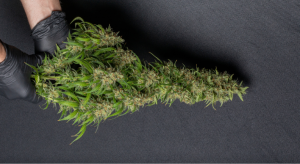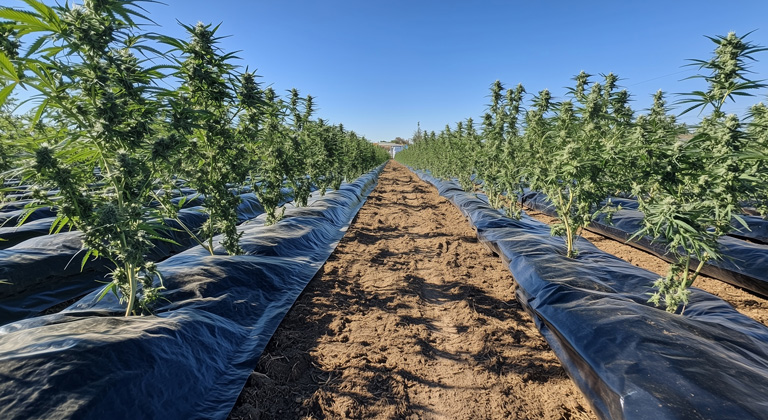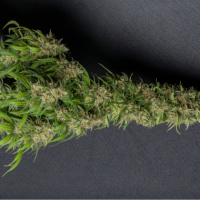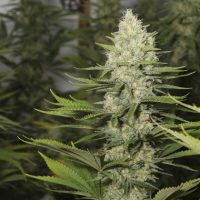In essence, mulching is the practice that involves covering the surface of the soil around plants. Far from being a simple aesthetic detail, this is one of the most powerful and transformative techniques in regenerative agriculture.
For an outdoor cannabis grower, mastering the art of mulching means moving from merely growing plants to orchestrating an ecosystem. It means working with nature, not against it, to create healthier and more productive plants with less effort, less water, and fewer interventions.
In short, it’s about creating a fundamentally more robust and self-sufficient growing system.
Traditional Mulches and Their Secrets
Organic mulches are the cornerstone of sustainable growing. They are derived from natural materials that break down over time. Each type has a unique personality, with a distinct set of strengths and strategic considerations to keep in mind.
Straw and Hay, the Rural Classic
A bale of wheat straw bound with a rope contains thousands of hollow stalks filled with silica. When spread out, these form a spongy mat that allows oxygen through and slows evaporation. Applying 5 cm of straw after the first post-transplant watering session can reduce irrigation cycles by up to 40% during Mediterranean heatwaves. However, it is advisable to fluff it every three weeks to prevent it from turning into a slug haven.
Hay, on the other hand, is more problematic. It retains leaves and seeds but it supplies more nitrogen (approx. 1.4%), and is ideal during the vegetative stretching of cannabis. However, you need to make sure you dry it in the sun before using it to deactivate seeds and saprophytic fungi.
Wood Chips, Mycelium à la Carte
Cannabis growers in forest climates use pine chips or oak bark aged at least 12 months. During that period, the population of filamentous fungi colonizes the lignin and neutralizes the “theft” of nitrogen that can occur when using them fresh. Placing 7 cm of wood chips around the stem, without touching it, creates a mat that slowly releases nutrients over several seasons. This is perfect for permanent no-till crops.
Dry Leaves and Good Mold
When autumn is allowed to follow its course, leaves can be shredded with a trimmer to form mold within 6-9 months, which is rich in humic acids. When used in cannabis crops, this improves water infiltration and “heals” clay soils. It is recommended to use an 8 cm layer at the end of the season so it decomposes in winter to feed the soil before the next sowing.
Cannabis Remains to Close the Cycle
After manicuring, the leaves, stalks, and roots can be fermented with bran and microorganisms in an airtight bucket for 14 days. After this time, a 3 cm layer can be spread out and then covered with straw. The residual trichomes feed the bacteria, and the lignin from the stems adds porosity. Growers report up to 10% more biomass in subsequent crops thanks to this “native mulch”.
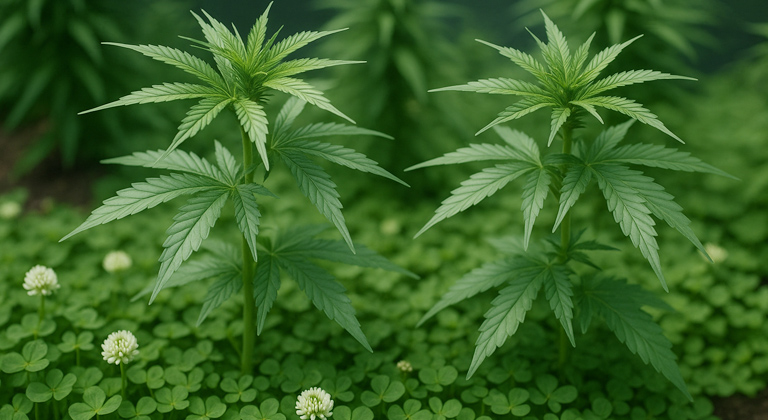
Seaweed: Liquid Gold
On the Cantabrian coast, growers collect sargassum seaweed washed up after spring tides. When washed a couple of times and spread in a 4 cm layer, this seaweed provides potassium, boron, and cytokinins that promote flowering. Additionally, it can retain water thanks to its gelatinous texture, so it’s incredibly useful in sandy soils. It’s important to remember to remove any shells, as these can introduce marine pathogens or unbalance the pH due to their calcium carbonate content.
Rice Husks as Weed Repellents
USDA researchers demonstrated that a 1 cm rice husk cover prevented 100% germination of cress and hepatica in pots. Its ultra-light density facilitates aeration, making it perfect for SmartPots where the substrate tends to become compact. In windy outdoor locations, it’s recommended to moisten it or mix it with 10% compost to prevent it from being blown away.
Dry Grass and Garden Prunings
Free and plentiful, grass transforms into a high-nitrogen mulch if allowed to dry for 48 hours. A top layer with a thickness of 4 cm can ferment and reach 60°C, damaging tender roots, so it’s best to use thin layers and repeat weekly. Ensure the grass hasn’t been treated with herbicides, which could transfer to cannabis through leaching.
Live Mulches Are Your Best Allies
There’s a more dynamic approach to the use of dead organic matter as ground cover which involves the use of live plants. Known as “living mulches” or “cover crops,” these systems transform the soil into an active and symbiotic ecosystem which requires active management to balance cooperation and competition.
Clover, especially low-growing varieties like the Dutch white clover, is cannabis’ ultimate companion. Its superpower lies in its symbiotic relationship with the Rhizobium bacteria, which live in its roots and are able to capture nitrogen from the air and convert it into a form that cannabis plants can absorb, thus providing a free source of slow-release nitrogen.
Moreover, this dense cover can suppress weeds, retain moisture, and attract beneficial insects. The key to its use is the “cut and drop” technique: when the clover grows too big, it is cut, with the clippings being left on the ground, where they quickly decompose, releasing the accumulated nitrogen and fertilizing the cannabis crop.
Other leguminous plants like the hairy vetch (Vicia villosa) are even stronger nitrogen fixers capable of choking out almost any spring weed. However, their vigor is also their greatest risk: if not controlled, they can climb and suffocate cannabis plants. Therefore, they’re often used as a cover crop that is sown before and cut or crushed just before cannabis is transplanted, creating a thick mat of natural nitrogen-rich mulch.
The Synthetic Frontier as a Philosophical Choice
At the opposite end of the spectrum are synthetic materials like black plastic and geotextile mesh, which represent a philosophy of control over nature rather than a collaboration.
Black plastic is effective for controlling weeds and warming the soil, which can accelerate early growth. However, its drawbacks are severe and long-term. As it’s impermeable, it suffocates the life in the soil, killing essential microorganisms, creating a biologically dead environment, increasing runoff, carrying fertilizers to waterways, and eventually degrading into microplastics that pollute soil and water for centuries.
Geotextile or gardening mesh is marketed as a permeable alternative, but its effectiveness is often a broken toy. Over time, dust and organic debris accumulate on the fabric, creating a new layer of soil where weeds can happily germinate. Worse yet, their roots become entangled in the fabric, making removal almost impossible whilst also degrading the soil life beneath.
The choice between organic and synthetic mulches is ultimately a philosophical choice: to either nurture a living and self-sustaining system or to suppress nature at a high ecological cost.
Mastering the Mulching Technique and Resolving Issues
Theoretical knowledge is the foundation, but execution is what really makes the difference. Regardless of the organic material chosen, the golden rule is always the “donut method”: never pile mulch directly against the plant’s stem. Always leave a few centimeters of bare soil around the base, which prevents moisture from getting trapped, preventing stem rot, a fungal disease that can be lethal.
An expert grower can even guide the microbial profile of the soil. During the vegetative phase, when cannabis needs more nitrogen, fresh “green” mulches (such as grass clippings or clover) can stimulate bacterial populations, making nitrogen more available. When switching to the flowering, the plant demands more phosphorus and potassium, so “brown” and woody mulches (wood chips, straw) promote a soil dominated by beneficial fungi, which in turn slightly acidify the environment, making these flowering nutrients more accessible for the roots.
Cultivating in Harmony with the Soil We Walk On
We’ve traveled from the simple surface of the soil to the complex interactions of the underground food web, demonstrating that mulching is much more than a mere gardening task: it’s a statement of intent, a strategic choice that defines the grower’s relationship with their environment.
The conclusion is unequivocal: the best mulch isn’t a universal product but a decision that depends on the climate, resources, and most importantly, the grower’s philosophy. By choosing to feed the soil with straw, wood chips, or a living cover of clover, we’re not only growing cannabis: we’re cultivating life, biodiversity, and a more self-sufficient system that produces plants of exceptional quality in true harmony with nature.

